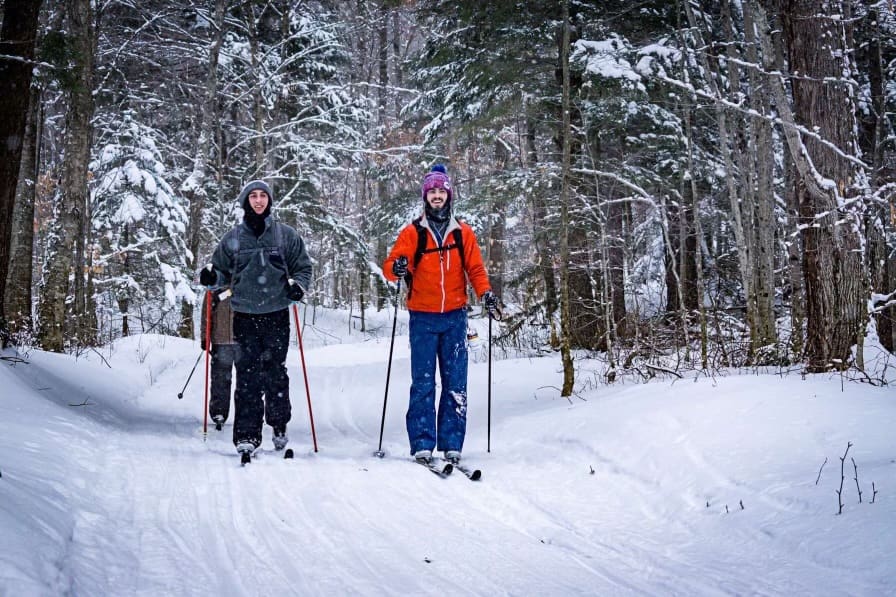Gearing Up for Northern Arizona Ski Season
Early winter storms have arrived in Northern Arizona, and with them, so too has the anticipation for ski and snowboard season here in Flagstaff. Peace Outfitters employee Ian Bradford is already dreaming of – as well as planning and preparing for – days spent under alpine sun on his skis. “It’s an activity that provides a harmonious balance of adrenaline and tranquility,” he says. Fresh powder is his favorite, noting that it creates an atmosphere second to none. “And it’s best finished with a hot meal and a cold beverage,” he adds.
Like Ian, many in Flagstaff are pulling out their skis, snowboards, helmets, and goggles to gear up for another winter season. But poring over gear and layers, as well as making sure you’re physically ready for long days through deep powder, can be a daunting task. At Peace Outfitters, we’re here to help you make sure your gear is in top form so you can enjoy all that winter has to offer, whether you’re skinning up Arizona Snowbowl in the light of a headlamp or cross-country skiing through the trees at the Nordic Village.

Getting Your Gear Ready
In any outdoor pursuit, having the right gear is critical for performance, safety, and fun. The same goes for the winter gear that you use to ski, snowboard, or snowshoe. Just as you do with your tents, backpacks, and sleeping bags before backpacking, it is vital to prepare your skis, board, boots, bindings, helmets, and goggles to get back onto the slopes.
- Skis and snowboards
Give your skis and/or snowboard a general check-in. Look for any visible damage to your gear that may have happened toward the end of last season, such as scratches, dents, or bent edges. If there are any significant gashes or dents on the base, you might need to get them filled in with P-Tex. You can use your fingernail to check if these damages require immediate repair by using your fingernail – if your fingernail catches on the scratch, it should be fixed immediately. You can also use your fingernails to check for burrs or rust along the edges of your skis or board.
Take a close look at the base of your skis or snowboard to see if they need a pre- or early-season wax (hint: they probably do). If the bases look dry, white, or fuzzy, they will require a layer or two of wax.
- Boots and bindings
For ski boots, check for any cracks on the shell or damage/defects on the buckles. For snowboard boots, make sure that the upper still seems in good condition and that the toe cap or sole of your boots are not showing any signs of separation or delamination. For both ski and snowboard boots, it is also important to check your liners. If they got ground to dust from skiing/snowboarding frequently last season, you may be able to get them heat molded to breathe some life back into them.
From a safety perspective, bindings are one of the most important components of your ski or snowboard kit; as such, it is vital to ensure that your bindings are in good condition. Look for any obvious wear and clean of any dirt or grime that may be lingering from last season. From there, ensure that your bindings are set to the appropriate release settings and check that they open and close smoothly. Verify that the brakes deploy properly as well. You can do all of this by putting your boots on and stepping into your bindings in your house – or swing by a ski shop and work with a professional ski technician if that feels more comfortable.
- Helmets and goggles
Inspecting your helmet is another key safety facet of pre-season preparations. If you do not own a helmet, always rent one. Helmets perform the paramount function of protecting your head in the case of a nasty fall or collision, but most helmets are only good for one big impact. If you see any cracks, dents, or other damage in the shell of your helmet, it is time to replace it – no questions asked. This includes helmets that use MIPS (multi-directional impact protection system). Even if a MIPS helmet looks fine, the foam inside may be compressed and thus cannot absorb impact as well. Lastly, always replace your helmet every 3-4 years, regardless of how well you have cared for it.
For your goggles, make sure that there are no scratches or cracks on the lenses that could be annoying or even compromise your visibility while on the mountain. Fit-wise, you want to ensure that they are smooth on your face and snug around the perimeter – there should be no gaps between the foam padding and your face. It is also good to check that your goggles are compatible with your helmet so that they pair seamlessly together. There should be no gap between the top of your goggles and the brim of your helmet, but your helmet also should not be pushing down on your goggles.
- Cross-country skis
Check your XC skis almost the same way you check downhill skis, looking for cracks, scratches, or dents to the bases and edges. For XC skis, however, you should also pay extra attention to the glide zone (the tips and tails); if your XC skis were left without wax since last season, you will need to clean the glide zone. Use a glide cleaner, like one from Swix, to apply a generous amount to a piece of fiberline paper and rub it back and forth on the ski. Then, use a nylon brush to scrub glide zone, before wiping clean with fiberline again.
- Snowshoes
If you are someone who finds themselves on snowshoes rather than skis or a snowboard, you will still need to check those snowshoes before taking them out for their first excursion of the year. Here, it is easy to give your snowshoes a quick physical inspection. Look for any bends or breaks in the frame, test all straps or BOA functions on your bindings, and ensure that the traction (that is, the actual crampon spikes) are sharp, unbent, and securely attached to the frame. Lastly, tighten any bolts or screws that may have loosened over the course of last season.
- Layers
When you think of your ski and snowboard gear, the first thing that comes to mind is not likely the layers and clothing you wear while on the slopes. However, these pieces are important in keeping you warm, dry, and safe in the snow. Just as the hard gear in your ski or snowboard kit (i.e., your skis, boots, and bindings) can wear down, so too can your layers. And it is no fun to realize that your shell has wetted out while sitting on the lift or after having taken a fall in deep powder.
First, look for any obvious holes or tears in your snow jacket and snow pants. If there are any holes, consider repairing them with waterproof patches or tape, or – if necessary – replacing them entirely. Next, check on the inside of your waterproof layers to look for delamination in the linings. If linings are peeling or starting to look like they are bubbling, it is probably time for some new apparel. Lastly, check the waterproofing of the outer shells by running them under a faucet or hose. Ideally, you want to see water beading and running off the material; if it looks like it’s lingering and soaking through, again, it is probably time to go shopping. If necessary, you can use a waterproofing treatment like DWR spray to extend the life of your layers, but this is only a temporary solution.
Getting Your Body Ready
If your gear is all in working order and ready to for the snow, then you should ensure that your body is ready for the same. Skiing, snowboarding, cross-country skiing, and snowshoeing work different parts of the body and different types of muscles in different ways than do other outdoor pursuits throughout the spring, summer, and fall, such as running, climbing, and biking. Fortunately, there are a number of simple exercises and regiments you can follow to ‘winterize’ your body.
In general, focusing on your core, hips, quadriceps, and balance will best prepare you for long days on the mountain. Below are a few specific movements you can add to your gym routine or existing training program:
- Walking lunge with rotation
- Front squat
- Lateral ski jump
- Box jump
- Hip bridge with abductor squeeze
- Pistol squat (assisted or unassisted)
- Forearm plank
- Single-leg Romanian deadlift
Repeating these exercises 10-15 times (per side if applicable; 1 minute for planks) will go a long way in strengthening the muscles activated while skiing and snowboarding. Be careful not to overweight your barbell or dumbbell, particularly if you do not lift very often. In fact, if that is the case, it is best to stick to performing these movements with no weight or resistance.
Winter at Peace Outfitters
At Peace Outfitters, we’re equipped with a ski shop full of knowledgeable ski and rental technicians. Our staff is happy to assist you with finding the right helmet or goggles, as well as preparing and repairing your skis and/or snowboard. Our ski shop offers quick waxes, hot waxes, edge repair, and basic and performance full tunes for your equipment.
Don’t own your own gear and not so sure you want to invest just yet? No problem. We also have a full rental shop with inclusive rates. We rent ski and snowboard packages, cross-country ski packages, helmets, snowboard boots, ski poles, and snowshoes. Check out our website for more information: https://peaceoutfittersaz.com/ski/. Please note that we rent per day or multiple days, but we do not offer season-long rentals.
Whether you’re making your first-time helmet purchase, looking to get your new skis waxed and ready for the slopes, or just have questions on what it’s like to ski in Arizona, swing by Peace Outfitters and we would be stoked to help you. See you on the mountain!
